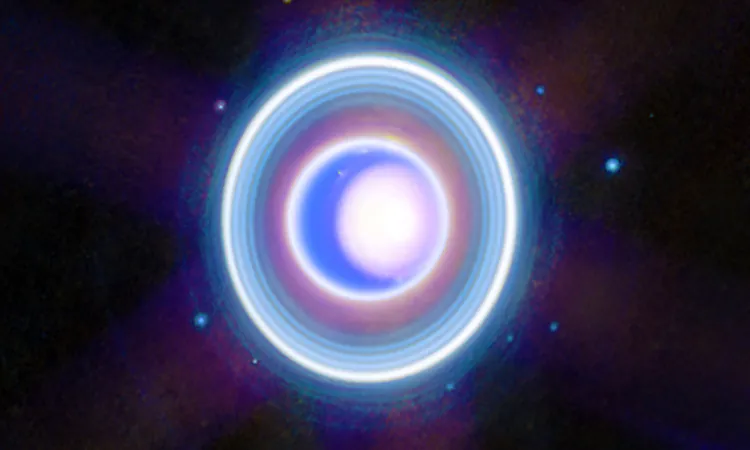
Exciting Discoveries: Uranus' Moon Miranda May Harbor an Ocean—and Possibly Life!
2024-11-04
Author: Jessica Wong
A groundbreaking new study has ignited excitement in the astronomical community: Miranda, one of Uranus' moons, may conceal a subsurface ocean beneath its icy exterior, potentially creating conditions suitable for extraterrestrial life.
Located in the far reaches of our solar system, Miranda presents a fascinating puzzle for scientists attempting to uncover secrets hidden beneath its frigid crust. Tom Nordheim, a planetary scientist at the Johns Hopkins Applied Physics Laboratory, has been at the forefront of this research.
“It’s incredibly surprising to find evidence of an ocean inside a small body like Miranda,” Nordheim, co-author of the study, remarked. This new understanding challenges previous assumptions about Miranda and opens discussions regarding the potential for life on celestial bodies that we once thought were inhospitable.
Miranda's Extraordinary Landscape
Voyager 2, NASA's pioneering spacecraft, first revealed the bizarre beauty of Miranda in 1986. Its landscape appears as if it has been stitched together from various geological formations, showcasing deep grooves, towering cliffs, and distinctive trapezoid-shaped areas known as coronae. These mesmerizing features prompt questions about the moon's geologic history and the forces that shaped its surface.
Uranus: The Enigmatic Ice Giant
Uranus, often overshadowed by its more famous planetary siblings, is unique in many ways. It rotates on its side, with its axis almost parallel to its orbital plane, resulting in extreme seasons that grant each pole 42 years of continuous sunlight followed by 42 years of darkness. This peculiar tilt is believed to be the outcome of a significant impact with an Earth-sized object early in its history.
The atmosphere of Uranus is rich in icy materials, such as water, ammonia, and methane. It possesses at least 27 moons, many of which are named after characters in Shakespearean plays, including the intriguing Miranda.
Revealing the Hidden Ocean
In this remarkable study, graduate student Caleb Strom and Alex Patthoff of the Planetary Science Institute collaborated with Nordheim to unravel Miranda's mysteries. They revisited images captured by Voyager 2, employing modern computer modeling techniques to recreate the moon's geologic past.
Mapping Miranda's intricate surface features led the team to a startling conclusion: approximately 100 to 500 million years ago, the moon likely contained a subsurface ocean at least 62 miles deep, lying beneath a frozen crust no thicker than 19 miles.
“It was a big surprise to the team that a moon as small as Miranda could have such a large ocean,” said Strom. The ocean may have remained liquid due to heating generated by tidal forces caused by gravitational interactions with Uranus and its other moons.
The Search for Life
While the case remains open, there's reason to believe this subsurface ocean could be in a tumultuous state rather than fully frozen over. The absence of expected surface features would indicate that Miranda's interior energy may still be active.
“Our suggestion of an ocean inside one of the most distant moons in the solar system is remarkable," Strom commented. Past discoveries such as Saturn's moon Enceladus, which has shown geysers ejecting water vapor into space, have shifted our understanding of where life might exist beyond Earth.
The ongoing research into Miranda is in its early stages; it’s too soon to confirm the existence of life. However, the prospect is tantalizing, and scientists stress the need for further data to support these claims. As Nordheim noted, "We’re squeezing the last bit of science we can from Voyager 2’s images," underscoring the urgency for new missions to Uranus that will work to confirm the presence of this moon's ocean.
In the ever-expanding landscape of our solar system, Miranda emerges as an unexpected beacon of potential. This small moon, once dismissed as a frozen wasteland, now stands at the forefront of our search for life beyond Earth. As investigations continue, we may find ourselves irresistibly drawn back to explore this icy moon and discover the wonders it may hold.
With the potential for new missions, who knows what exciting revelations still lie in wait? Whether it’s a hidden ocean or even life itself, one thing is for sure—our thirst for knowledge about Miranda and its celestial siblings is just beginning.



 Brasil (PT)
Brasil (PT)
 Canada (EN)
Canada (EN)
 Chile (ES)
Chile (ES)
 España (ES)
España (ES)
 France (FR)
France (FR)
 Hong Kong (EN)
Hong Kong (EN)
 Italia (IT)
Italia (IT)
 日本 (JA)
日本 (JA)
 Magyarország (HU)
Magyarország (HU)
 Norge (NO)
Norge (NO)
 Polska (PL)
Polska (PL)
 Schweiz (DE)
Schweiz (DE)
 Singapore (EN)
Singapore (EN)
 Sverige (SV)
Sverige (SV)
 Suomi (FI)
Suomi (FI)
 Türkiye (TR)
Türkiye (TR)